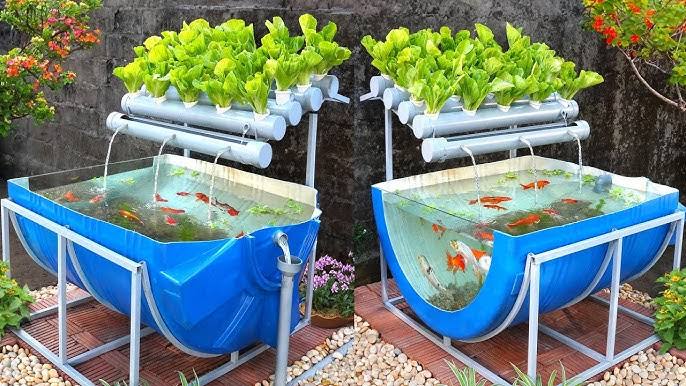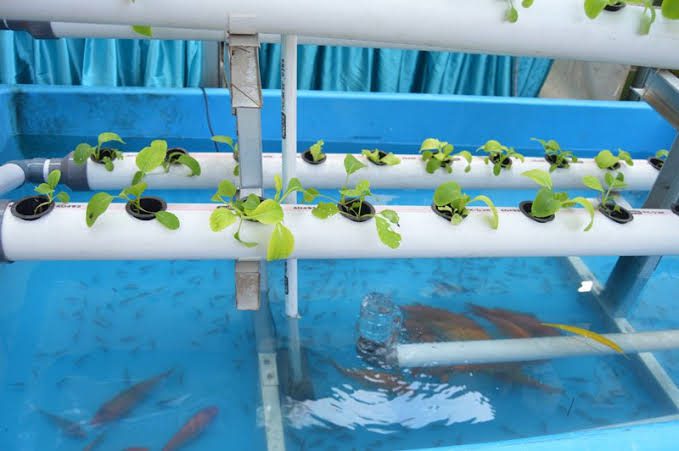Starting an aquaponics system means creating a unique and sustainable way to grow plants and raise fish together. It’s like building a small ecosystem in your backyard or indoors. Instead of using traditional soil, aquaponics relies on a symbiotic relationship between fish and plants.
In simple terms, you have fish swimming in a tank, and the waste produced by these fish is rich in nutrients. These nutrients are then used by plants as food. In return, the plants help filter and clean the water, creating a balanced environment for both fish and plants to thrive.
Imagine setting up a mini-world where fish and plants work together, each benefiting the other. Starting an Aquaponics System is about understanding and maintaining this delicate balance.
Firstly, you need a fish tank – this will be the home for your fish. You’ll choose the type of fish based on your preferences and the climate of your area. Popular choices include tilapia, trout, or catfish.
Next, you set up a grow bed – a place where your plants will grow. This could be a simple container filled with a growing medium like gravel or clay pebbles. The water from the fish tank is pumped into the grow bed, providing nutrients for the plants.
Now, the magic begins. As the fish swim around in their tank, they produce waste. This waste contains ammonia. Bacteria in the system convert this ammonia into nitrites and then into nitrates – a form of nitrogen that plants love. The nutrient-rich water is then pumped into the grow bed, nourishing your plants.
The plants, in turn, act as a natural filter, cleaning the water before it circulates back to the fish tank. This creates a continuous cycle where fish and plants support each other’s growth.
Starting an aquaponics system is not just about setting up tanks and grow beds; it’s about understanding the interconnectedness of the system. It’s like orchestrating a symphony where fish, bacteria, and plants play harmoniously.
Maintenance is crucial. You’ll need to monitor water quality, check for signs of diseases in your fish, and ensure that the pH levels are suitable for both fish and plants. It’s a hands-on approach, but the rewards are plentiful – fresh, homegrown vegetables and fish.
In essence, starting an aquaponics system is embracing a sustainable and efficient method of farming. It’s a journey where you become the caretaker of a small, thriving ecosystem, witnessing the fascinating dance of nature within the confines of your aquaponics setup.
Read Also: Impact of Snail Business on the Environment
How to Start an Aquaponics System

Starting an aquaponics system involves a few key steps to create a thriving ecosystem for both fish and plants;
1. Set Up a Fish Tank: Begin by selecting a suitable tank for your fish. Consider factors such as size, material, and the type of fish you want to raise. Ensure the tank is placed in an area with stable temperature and minimal fluctuations.
2. Choose the Right Fish: Select fish species that are well-suited for aquaponics, such as tilapia, trout, or catfish. Consider factors like water temperature, pH levels, and the availability of the chosen fish in your region.
3. Install a Grow Bed: Set up a grow bed or container where your plants will grow. Fill it with a suitable growing medium like gravel or clay pebbles. Place the grow bed above the fish tank, allowing water to flow from the tank to the grow bed.
4. Connect the System: Use a water pump to circulate water from the fish tank to the grow bed. This ensures that the nutrient-rich water from the fish tank is delivered to the plants. The plants, in turn, filter and clean the water before it returns to the fish tank.
5. Introduce Beneficial Bacteria: Introduce bacteria into the system to facilitate the nitrogen cycle. These bacteria convert fish waste (ammonia) into nitrites and then into nitrates, which serve as a valuable nutrient source for the plants.
6. Select Suitable Plants: Choose plants that thrive in aquaponic systems. Herbs, leafy greens, and certain fruiting plants are popular choices. Ensure the selected plants are compatible with the specific conditions of your aquaponics setup.
7. Monitor Water Parameters: Regularly monitor water quality parameters such as pH, ammonia levels, nitrite levels, and temperature. Maintaining optimal conditions is crucial for the health of both fish and plants.
8. Ensure Adequate Lighting: Depending on your setup (indoor or outdoor), provide adequate lighting for your plants. Natural sunlight or artificial grow lights can be used to support plant growth.
9. Maintain the System: Perform routine maintenance tasks, including cleaning filters, checking for signs of diseases in fish, and pruning plants as needed. Regularly inspect the overall health of the system to prevent issues.
10. Harvest and Enjoy: As your system matures, you can start harvesting both fish and plants. Enjoy the fresh produce and fish from your aquaponics system, and appreciate the sustainable and interconnected nature of this farming method.
Starting an aquaponics system is a journey that involves learning, observing, and actively participating in the balance of nature within your setup.
With proper care and attention, you can create a self-sustaining ecosystem that yields both nutritious food and a sense of environmental responsibility.
Read Also: How to Prevent Other Predators in a Snail Farm (Snail Business)
Benefits of Starting an Aquaponics System

The benefits of an aquaponics system are diverse and contribute to sustainable and efficient farming practices:
1. Resource Efficiency: Aquaponics utilizes water efficiently by recycling it through the system. The water used for fish also nourishes the plants, reducing overall water consumption compared to traditional soil-based agriculture.
2. Space Utilization: Aquaponics is adaptable to various settings, making it suitable for both urban and rural environments. Vertical or horizontal setups allow for effective use of limited space, enabling cultivation in areas with space constraints.
3. Reduced Environmental Impact: The closed-loop system minimizes the risk of nutrient runoff into surrounding ecosystems. This eco-friendly approach helps protect natural water bodies from pollution associated with traditional farming practices.
4. Year-Round Production: Aquaponics systems can operate year-round, providing a consistent supply of fresh produce regardless of external weather conditions. This feature is especially advantageous in regions with extreme climates or limited growing seasons.
5. Integrated Pest Management: The controlled environment of aquaponics systems reduces the likelihood of pests and diseases affecting plants. This minimizes the need for chemical pesticides, contributing to healthier and more natural produce.
6. Dual Harvest: Aquaponics offers a dual harvest of both fish and plants. This integrated approach provides a diverse range of products, including fresh vegetables and fish protein, enhancing the nutritional output of the system.
7. Nutrient-Rich Produce: The nutrient-rich water from the fish tanks enhances plant growth. As a result, aquaponically grown plants often contain higher levels of essential nutrients, offering a more nutritious end product compared to traditional soil-grown crops.
8. Educational Opportunities: Aquaponics systems provide valuable educational opportunities, especially for students and communities interested in sustainable agriculture. Learning about the interconnected relationship between fish and plants fosters environmental awareness.
9. Local Food Production: Aquaponics supports local food production, reducing the need for long-distance transportation and the associated carbon footprint. This contributes to the development of more resilient and self-sufficient communities.
10. Water Quality Control: Constant monitoring of water parameters in aquaponics systems ensures a controlled environment for both fish and plants. This attention to water quality promotes the overall health of the system and the well-being of the organisms within it.
In summary, the benefits of aquaponics extend beyond just agricultural productivity. This innovative farming method aligns with principles of sustainability, conservation, and responsible resource management, making it a promising approach for the future of food production.
Read Also: Water Business – Complete Beginners Guide

